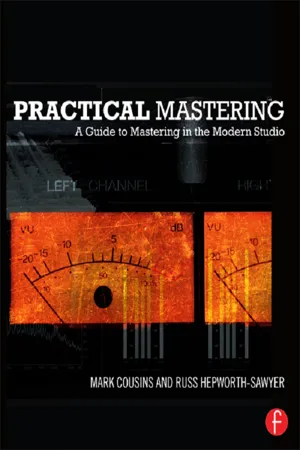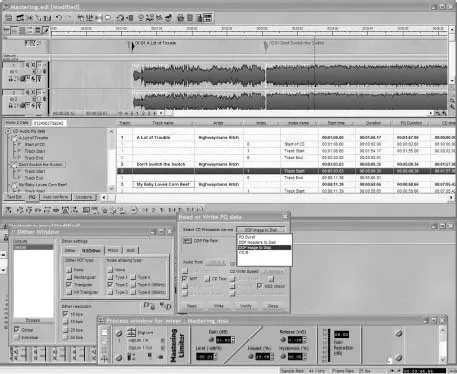
eBook - ePub
Practical Mastering
A Guide to Mastering in the Modern Studio
Mark Cousins, Russ Hepworth-Sawyer
This is a test
Compartir libro
- 244 páginas
- English
- ePUB (apto para móviles)
- Disponible en iOS y Android
eBook - ePub
Practical Mastering
A Guide to Mastering in the Modern Studio
Mark Cousins, Russ Hepworth-Sawyer
Detalles del libro
Vista previa del libro
Índice
Citas
Información del libro
Guiding you through the history and emergence of modern mastering techniques, then providing practical hints and tips on how to use them in your set up, Practical Mastering is the book for anyone interested in tackling this elusive art form. Providing you with sold mastering theory underpinned by years of professional experience and hands-on advice for getting the most out of your set up while honing your ears to efficiently and effectively listen to your mixes in order to create perfectly polished master tracks.
Preguntas frecuentes
¿Cómo cancelo mi suscripción?
¿Cómo descargo los libros?
Por el momento, todos nuestros libros ePub adaptables a dispositivos móviles se pueden descargar a través de la aplicación. La mayor parte de nuestros PDF también se puede descargar y ya estamos trabajando para que el resto también sea descargable. Obtén más información aquí.
¿En qué se diferencian los planes de precios?
Ambos planes te permiten acceder por completo a la biblioteca y a todas las funciones de Perlego. Las únicas diferencias son el precio y el período de suscripción: con el plan anual ahorrarás en torno a un 30 % en comparación con 12 meses de un plan mensual.
¿Qué es Perlego?
Somos un servicio de suscripción de libros de texto en línea que te permite acceder a toda una biblioteca en línea por menos de lo que cuesta un libro al mes. Con más de un millón de libros sobre más de 1000 categorías, ¡tenemos todo lo que necesitas! Obtén más información aquí.
¿Perlego ofrece la función de texto a voz?
Busca el símbolo de lectura en voz alta en tu próximo libro para ver si puedes escucharlo. La herramienta de lectura en voz alta lee el texto en voz alta por ti, resaltando el texto a medida que se lee. Puedes pausarla, acelerarla y ralentizarla. Obtén más información aquí.
¿Es Practical Mastering un PDF/ePUB en línea?
Sí, puedes acceder a Practical Mastering de Mark Cousins, Russ Hepworth-Sawyer en formato PDF o ePUB, así como a otros libros populares de Technologie et ingénierie y Ingénierie de l'acoustique. Tenemos más de un millón de libros disponibles en nuestro catálogo para que explores.
Información

CHAPTER 1 |
Introduction |
In this chapter
| 1.1 | An introduction to Mastering |
| 1.2 | The role of this book |
| 1.3 | Can I master in [insert your DAW name here]? |
| Knowledgebase | |
| 1.4 | The history and development of mastering |
| 1.5 | The early days |
| 1.6 | Cutting and the need for control |
| 1.7 | Creative mastering |
| 1.8 | The CD age |
1.1 An introduction to Mastering
Compared to all other parts of the production process, mastering is surrounded by the greatest amount of miscomprehension and mystery. ‘What makes a finished master sound like a “record”?’ ‘How do professional mastering engineers create such loud masters?’ and ‘Can mastering really turn my lackluster demo into something listenable?’ – the list of questions about possibilities and skills of mastering are almost endless. In truth, few of us can ignore the important role mastering plays – whether you’re demoing songs in a home studio, or working as a professional musician/engineer – so it’s well worth separating fact from fiction.
In its broadest sense, mastering forms the final part of the production process – the last opportunity to finesse the sound of a recording and the point at which we deliver a product ready to be replicated and delivered to the consumer. Over time, and with the rapid changes in technology over the last 40 years, the exact role and function of mastering has changed. Where mastering engineers might have once dealt with a cutting lathe and a vintage valve compressor, today’s engineer might be delivering internet-ready content mastered through a range of cutting-edge plug-ins. Either way, mastering is most effective when the music is conveyed as effectively as possible.
Arguably the most important development in mastering is that all musicians and engineers, to a lesser or greater extent, have to actively engage in the mastering process. The record industry of old – where just a handful of mastering engineers acted as gatekeepers to the outside world – has long gone, and instead, musicians and recording engineers have any number of avenues through which their music can be released. With budgets being stretched, release dates looming and ‘off-the-shelf recording technology delivering high-quality results, it’s a logical conclusion that the mastering process slowly becomes part of everyone’s recording workflow, just like the tasks of tracking or mixing.
Of course, there’s still a role for a professional mastering engineer – principally as a means of bringing some ‘fresh ears’ to a project, but also in utilizing some well-honed experience in the final stages of the production process. There’s also a wealth of specialist equipment that they can bring into the equation, most of which isn’t appropriate for conventional music production activities, or is simply too expensive for most of us to afford. That said, few people can choose to ignore the role mastering plays, and everyone can benefit from a greater understanding of the contribution that mastering makes to the record-making process.
1.2 The role of this book
Given a need to ‘self master’, this book is designed to equip you with all the skills relevant to working in today’s music industry. It recognizes the fact that a majority of engineers choose to mix and master ‘in-the-box’, but that there’s still a role for specialized mastering hardware, and indeed, a dedicated mastering engineer where appropriate. Most importantly, it illustrates what all of us can realistically expect to achieve with access to a reasonable set of production tools (in other words, a DAW and a small, well-chosen collection of plug-ins), as well as defining the limitations and potential pitfalls that such an approach can deliver.
If you’re starting out in music production, therefore, this book is a ideal way of understanding how mastering can improve your music and how you can best integrate your output with the rest of the audio world. Starting from the basics, we’ll look at the key processes and techniques behind mastering – whether you’re using a compressor to better control the dynamics of a piece of music, or assembling a finished DDP (Disc Description Protocol) master ready for replication. We’ll also guide you through the key issues of the day, including the ever-present loudness war and what this means to audio quality and music in general.
For the more experienced user, the book illustrates a more refined understanding of the tools you have at your disposal – understanding how equalization, compression and limiting interact to transform a basic mix into a finished master. Rather than just skipping through presets, you’ll gain better understanding about the role and relevance of each individual parameter, and how you can tweak these controls in a meaningful way to achieve a defined objective. You’ll also form a better understanding of the wider principles of mastering – from the ethos and thinking behind ‘professional quality’ audio, through to the technical details, like delivery formats and so on, that are so important to how you interact with the wider audio industry.
1.3 Can I master in [insert your DAW name here]?
In writing this book we’ve tried to strike a balance between universal information (in other words, good audio mastering practice that can be applied in almost any digital audio workstation, or DAW), and advice and guidance that relates to specific applications and plug-ins. The majority of the book deals with what we consider to be the key skills of mastering – focussing on areas such as dynamics and timbre as well the mechanics of putting together a finished product. Although the precise nature of what you can achieve will vary from DAW to DAW, it’s interesting to note the universality of many of these skills. At the end of the day, all DAWs offer some way of editing, equalizing and compressing an audio file, which means that you can at least start to practice and apply some of the principles of mastering.
Knowledgebase
Mastering: a step-by-step guide
The first stage of mastering is generally concerned with the sound of the finished master, using tools such as compression, equalization and limiting to create a balanced and homogenous listening experience. Deficiencies in the mix (such as a weak bass or an over-aggressive snare drum) can often be refined by the considered application of signal processing, and a good engineer can also ensure that the track has a suitable dynamic range and timbral balance so that it translates across a range of listening environments. It’s also important that the album as a whole sounds balanced – that tracks have an even loudness, for example, and that they share a similar tonal colour.
Once the sound of the masters is established, an engineer can look towards editing and ordering the final playlist for the tracks. The beginnings and ends of tracks will often need some attention – removing unwanted noise at the track’s start, for example, or applying a fade-out over the last chorus. Assuming you’re mastering an audio CD, it’s also important to consider the gaps between tracks and additional factors such as ID markers that might help the listener navigate the music that’s presented to them.
The final stage is delivery: ensuring that the final product is suitable for the next stage of production. If you’re creating a CD, for example, you might need to deliver the master in DDP format (Disc Description Protocol), or you might simply be delivering audio files (in a given format) if the material is going to be used on the Internet. Either way, it might also be important to embed additional metadata – such as ISRC codes, composers’ names and so on – so that your music can be tracked and monitored correctly in the digital universe.

The process of mastering is predominantly focused on the task of assembling a finished product ready for replication.
Towards the end of the book, though, we’ve also included a chapter that looks at a number of specific applications – highlighting the key operational points you need to be aware of, as well as the principle differences that exist between the different working methodologies. To keep the information succinct it isn’t an exhaustive explanation, but instead offers an illustration of how the various techniques we’ve described can be applied in a number of leading DAWs and plug-ins. Given the flexibility inherent in most platforms, and the growing number of new plug-ins released on a daily basis, it’s well worth you exploring beyond this and seeing just how much you can achieve!
1.4 The history and development of mastering
Arguably the best way of understanding mastering today is to look at how the role of mastering has changed and evolved over the years. Accepted practices that we assume to be de rigueur have developed over many years to become the art form we now appreciate. Of course, to adequately provide a proper and detailed history of mastering would necessitate a book in its own right, so hopefully this provides an insight into the changes that have happened rather than being an exhaustive exploration.
Mastering as we know it today has been borne out of a number of technological and aesthetic developments which, to the untrained eye, seem to be far removed from the origins of the role. Yet over time these developments in technology, distribution and listening habits have resulted in a set of changes in the world of mastering. We now pause to take a concise look at the history of mastering, hoping to bring context to an already misunderstood art form.
1.5 The early days
Back in the earliest days of recording, a sound engineer principally worked as a ‘jack-of-all-trades’, being both the ‘recording engineer’ and the ‘cutting engineer’ as part of the same process. Equipment was limited, with often just a single microphone to capture a full ensemble, which was then used as the sound source to cut the performance direct-to-disc. The recordings were imbued with energy and plenty of imperfections, but engineers still tried their best to ensure that they captured the true spirit of the original lineup and performance.
A significant shift came with the invention of magnetic tape, which meant that the recording process could be separated into two distinct stages – that of capturing the performance, and secondly, the process of cutting the performance to disc. In effect, what we now know of as a mastering engineer started life as a transfer engineer, ensuring that the music recorded to tape was transferred to a subsequent format as effectively as possible. Their concerns weren’t necessarily artistic, but instead were to ensure the transfer retained the sonic qualities of the original source recording as effectively as possible. Even at this stage, you can see why high-quality monitoring is so important to a transfer engineer (latterly to become a mastering engineer) as their job relied on a near-flawless transition!
The revolution offered by magnetic tape culminated in the development of multi-track recording, which led to a further demarcation of the recording process – this time creating a distinct third role of a mixing engineer. Over the 1970s and 1980s, therefore, the art of the sound engineer evolved in completely distinct and separate ways, with recording engineers concentrating on capture, mixing engineers concentrating on balance and mastering engineers becoming highly skilled at the process of cutting music to vinyl. Technical standards were understandably high and engineers honed their skills in a defined part of the production process, arguably creating a real ‘golden age’ of recording.
1.6 Cutting and the need for control
The skillset that evolved in line with the procedures and practices of vinyl cutting were born both from technical limitations of the format, and, latterly, the desire to exploit the creative potential of the mastering process (which we’ll return to later on). To ensure these limitations were avoided, cutting engineers would be responsible for transferring the master tape to an acetate without it causing issues with later playback. For example, too much bass could cause many styli to leave the comfort of the correct groove, and cutting engineers might use high-quality filters to soften the bass load on a track, or at a specif...